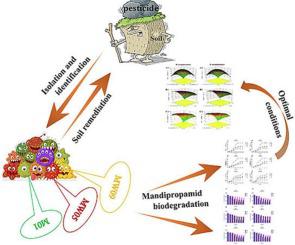Pesticide Biochemistry and Physiology ( IF 4.7 ) Pub Date : 2023-02-27 , DOI: 10.1016/j.pestbp.2023.105376 Shiyin Mu 1 , Li Dou 1 , Yu Ye 1 , Hao Zhang 1 , Jing Shi 2 , Kankan Zhang 1

|
Bacteria-induced biodegradation techniques have become an effective approach for removing pesticide residues from polluted soils. However, their effect on chiral fungicides must be systematically evaluated and the efficiency and risk of each chiral enantiomer must be better understood. In this study, we isolated and enriched seven bacterial strains that are able to degrade mandipropamid from contaminated soil samples. Three bacterial strains with high degradation efficiency (63.6%–73.4%) were screened and identified as Pseudomonas sp. (M01), Mycolicibacterium parafortuitum (MW05), and Stenotrophomonas maltophilia (MW09) by morphological and 16S rRNA gene sequencing analyses. The degradation characteristics of three strains (M01, MW05, and MW09) was investigated and it was revealed that pH, temperature, and initial concentration of mandipropamid significantly impacted their degradation efficiency. The optimal conditions for degradation were a nutrient source of mandipropamid and an inoculation amount of 5%. We used a Box-Behnken model experiment and an analysis of variance to determine the most suitable conditions for degrading mandipropamid at various pH, temperature, and initial concentration levels. A response surface methodology analysis showed that the three strains had the highest mandipropamid degradation efficiency (> 96%) under various conditions (pH: 7.15–7.71, temperature: 28.61–30.76 °C, initial concentration: 5.524–5.934 mg/L). Mycelial, intracellular, and extracellular enzymes also had an impact on the degradation of mandipropamid enantiomers by the three strains. In soil remediation trials, the three bacterial strains could effectively enantioselectively degrade rac-mandipropamid residues in polluted sterilized and natural soil samples (R-enantiomer was degraded faster) and influence the activity of urease and β-glucosidase in the soil. The results revealed several candidate bacterial strains for mandipropamid biodegradation and provide information on mandipropamid biological detoxification in soil environments.
中文翻译:

三种抗双虫胺菌株的分离、鉴定、降解特性及其在污染土壤修复中的应用潜力
细菌诱导的生物降解技术已成为去除污染土壤中农药残留的有效方法。然而,必须系统地评估它们对手性杀菌剂的影响,并且必须更好地了解每种手性对映体的效率和风险。在这项研究中,我们分离并富集了七种能够从受污染的土壤样品中降解 mandipropamid 的细菌菌株。筛选出三株降解效率高(63.6%~73.4%)的菌株,鉴定为假单胞菌。(M01)、偶发分枝杆菌(MW05) 和嗜麦芽窄食单胞菌(MW09) 通过形态学和 16S rRNA 基因测序分析。研究了三种菌株(M01、MW05 和 MW09)的降解特性,发现 pH、温度和双虫酰胺初始浓度对其降解效率有显着影响。降解的最佳条件为mandipropamid营养源和5%的接种量。我们使用 Box-Behnken 模型实验和方差分析来确定在各种 pH 值、温度和初始浓度水平下降解双虫酰胺的最合适条件。响应面法分析表明,三种菌株在各种条件下(pH:7.15–7.71,温度:28.61–30.76 °C,初始浓度:5.524–5.934 mg/L)具有最高的 mandipromid 降解效率(> 96%)。菌丝体,细胞内和细胞外酶也对三种菌株对双氨嘧啶对映异构体的降解产生影响。在土壤修复试验中,这三种菌株可以有效地对映选择性降解rac -mandipropamid 在污染的灭菌和天然土壤样品中的残留(R-对映异构体降解更快)并影响土壤中脲酶和 β-葡萄糖苷酶的活性。结果揭示了几种用于 mandipropamid 生物降解的候选细菌菌株,并提供了有关土壤环境中 mandipropamid 生物解毒的信息。



























 京公网安备 11010802027423号
京公网安备 11010802027423号